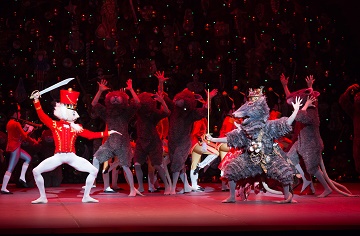By Megan O’Brien, deputy inside editor
A flurry of people ranging from senior couples to young children in patent leather shoes and their Sunday best filled the Boston Opera House on Friday evening. The auditorium brimmed with whispers and antsy movements until the first iconic note of Tchaikovsky brought the audience of the 2,677-seat theater to attentive silence.
The Boston Ballet’s production of “The Nutcracker” enjoyed its opening night on Nov. 27. The classic holiday tale follows Clara, portrayed by Boston Ballet School student Delia Wada-Gill, as she is whisked away to a magical kingdom when her toy nutcracker comes to life on Christmas Eve.
Each year, Boston Ballet performs a version of “The Nutcracker” choreographed by Artistic Director Mikko Nissinen, which premiered in 2012.
Nissinen’s take on the holiday ballet sticks close to the classical aesthetic audiences have come to love, while finding ways to blend in his individual flair. He keeps every character in a scene occupied, not letting any opportunity to create and flesh out action slip by. During the adults’ dance number at the Christmas party in Act I, Clara’s Grandmother and Grandfather dance with each other less theatrically off to the right side of the stage. Instead of having the party guests simply give a polite wave goodbye, each character has a distinct exit. One man carries his already sleeping daughter, while two siblings duel with their new toys all the way offstage.
Nissinen finds ways to sneak small moments of humor into his “The Nutcracker.” As each mouse’s entrance to Clara’s home is announced with a chime of a grandfather clock and a spotlight, a few take a simple stance with arms raised. A couple of mice appears in an amusing position on the floor, and one even sticks a tailed rump just beyond the curtain’s edge, inciting snickers from the audience.
While Nissinen was effective at setting the scene, his choreography did not match the power of the score at times, specifically during the duet.
The subdued choices, however, were helped by the tremendous technique Boston Ballet company members possess. While some younger cast members like Django Mason, dancing the role of Clara’s brother Fritz, were sometimes too focused on the movements rather then the acting a ballet of this kind requires, most of the Boston Ballet School pupils kept up with adult company members. Lasha Khozashvili and Ashley Ellis danced the roles of Snow King and Queen, respectively, performing the first duet of “The Nutcracker.” Khozashvili was a strong partner, allowing Ellis’ promenades to be especially stable. Her already-long extensions lifted even further upon finishing each one. Misa Kuranaga, in the role of the Sugar Plum Fairy, exquisitely articulated each and every movement of her limbs.
Audience members were pulled into the Nutcracker Prince’s fantastical world through the materialization of Robert Perdziola’s set design. The flattened style of many of the sets gave the feeling of watching a storybook come to life, especially at the top of the second act when, for a few moments, only a square of curtain was pulled back to reveal the Nutcracker Prince’s kingdom inside. The remainder of the curtain was stripped away to unveil the entirety of the set, including a series of chandeliers extending in two diagonal lines away from the stage’s center. Two were hung just beyond the stage, pulling the audience further into the action. While other whimsical elements, like Drosselmeier’s toy cannon – which actually emits smoke – or the crescent moon vessel that transports Clara and the Nutcracker high above the stage floor, are attractive additions, some tricks and fanfare detracted from the ballet.
Nissinen’s “The Nutcracker” breathed freshness into a production that is seemingly-ubiquitous during the holiday months. The production will surely entertain any viewer, from first-time audience members to those who know the score so well they hum along.
Photos by Rosalie O’Connor, courtesy Boston Ballet









